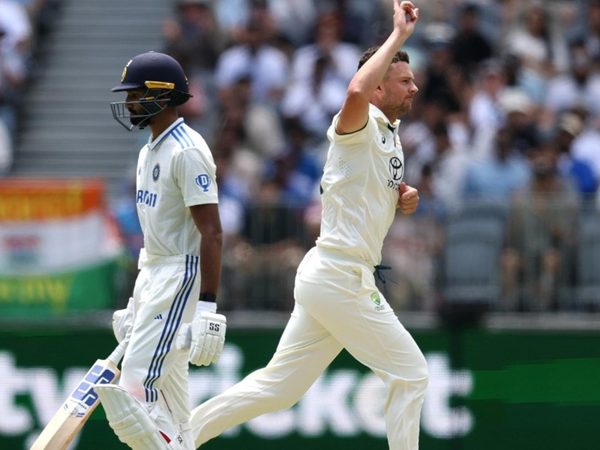
Watch: At Old Trafford in 1956, Jim Laker became the first – and till date, only – bowler to take 19 wickets in a first-class match, let alone a Test match.
Jim Laker had been doing Jim Laker things right from his school days. He once took 6-0 for Saltaire High School to help bowl out a side for one.
Posted as a corporal at Cairo during the Second World War, Laker claimed 6-10 against the Australian Servicemen. The Egyptian Gazette ran the headline “Laker Skittles Australians”. Prophetic, you may call it.
In 1950, Laker played a Test trial match for ‘England’ against The Rest. Here, he got 14-12-2-8. One of the runs was a gift to his friend Eric Bedser as per prior arrangement. The other happened when Laker collided with Trevor Bailey as both men ran to pick up the ball.
Between 1952 and 1958, Surrey won the County Championship a record seven times in a row under Stuart Surridge, and would almost certainly have beaten several international sides.
There were several stars in the team – Peter May, Ken Barrington, Tony Lock, Alec and Eric Bedser, Peter Loader – but Laker (1944 first-class wickets at 18.41) was arguably the greatest of them all.
And he replicated that success in Test cricket (193 wickets at 21.24). Perhaps the most obvious candidate for the off-spinner’s role in a World XI in the era preceding the doosra or the carrom ball.
But let us return to 1956, the year when Brylcreem announced £100 and a silver cup for the best bowling figures for the English summer.
Laker began the race with 10-88 for Surrey, against the touring Australians. Little did anyone realise that he was simply warming up.
In June, Ken Smailes of Gloucestershire claimed 10-66 against Worcestershire. In July, Lock got 10-54, for Surrey against Kent – but in Laker’s absence.
Spare a thought for the hapless Australians. They had regained the Ashes in England in 1934, and had held on to it until 1953 before England beat them both home and away.
The baton captaincy had since passed on from Len Hutton to Peter May, but the England team had remained the same. After a draw, Australia won by 185 runs at Lord’s, but Laker (11-113) and Lock (7-81) destroyed them at Headingley.
The Old Trafford pitch was, thus, expected to be spinner-friendly, but curator Bert Flack took it to another level. Bailey, who played in the Test match, called the dry, white dustbowl a “beach”.
After a storm during the Test match, a photograph of the ground staff sweeping a pile of dust off the surface hit the newspapers, giving an indication of how brittle the pitch was. May did not hesitate to drop Fred Trueman, no less: pace was redundant.
Thankfully, the newspapers had other things to cover – like the Suez crisis and the wedding of a Hollywood megastar. Australian captain Ian Johnson overheard Flack say “If it wasn’t for [Gamal Abdul] Nasser and [Marilyn] Monroe, I’d be on the front pages every day.”
Before the Test match, Keith Miller checked the playing strip and announced “gentlemen, we’re going to have an early finish” to the umpires.
May won the all-important toss and batted. England rode on Peter Richardson’s 104 and David Sheppard’s 113 to make 459 in four sessions. And when Colin McDonald and Jim Burke took Australia to 48-0, the fears seemed unsubstantiated.
But now May switched the ends for both spinners, and the collapse began. Laker had McDonald caught at short leg and, two balls later, pitched one on leg-stump to hit the off-stump of the left-handed Harvey.
Lock took out Burke before Laker claimed 7-8 in 22 balls in 35 minutes to finish with 9-37. Australia, bowled out for 84, were 53-1 at stumps. By then, McDonald had retired hurt with an injured knee, and Harvey had hit a full-toss to mid-on.
To top an already near-unplayable pitch, it now rained. Australia crawled to 59-2 in 45 minutes of cricket on day three and, on the other side of the rest day, 84-2 by stumps on day four.
At this point, Australia wanted the rain to continue, but it stopped raining at five in the morning of the final day. McDonald, having resumed his innings, batted until lunch with Ian Craig. England needed eight wickets in two sessions.
But the elements now added a third dimension to the equation. The sun shone brightly, baking the clayey pitch hard and dry; and a very strong wind blew around the ground, at times blowing the bails away.
Now the ball began to spin at absurd angles. McDonald batted for over five and a half hours for his 89; Craig, over four hours for his 38. And a young Richie Benaud did whatever possible to kill time, taking guards frequently, tapping the pitch, batting for an hour and a quarter.
One by one they perished to Laker as he finished with 10-53. Anil Kumble (10-74) and Ajaz Patel (10-119) have also taken 10 wickets since, but Laker’s remains the best innings figures.
Laker also remains the only bowler to take 19 wickets in first-class cricket. No bowler has taken even 18 in an 11-a-side first-class match.
Laker drove back home from Old Trafford that day. En route, he halted at Lichfield, Staffordshire for “a couple of very stale cheese sandwiches” and beer, and watched himself bowl on television. Those present at the pub praised him… without an inkling of the fact that he was there in person.
By the time he was back home, his house had already been flooded by congratulatory messages, which confused his Austrian (and cricket-agnostic) wife Lilly enough to ask her husband: “Jim, did you do anything good today?”
Of course, these were different times. The next morning, Laker, May, and Lock were back playing for Surrey against the Australians, who included six players from the Test match.
Watch Jim Laker take 19 wickets:







